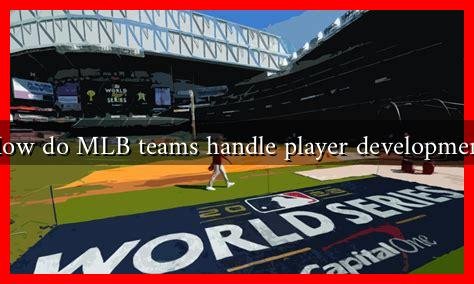-
Table of Contents
- How Do MLB Teams Handle Player Development?
- The Importance of Player Development
- Key Components of Player Development
- 1. Scouting and Drafting
- 2. Minor League Affiliates
- 3. Coaching and Training
- 4. Analytics and Technology
- Case Studies: Successful Player Development Programs
- The Atlanta Braves
- The San Diego Padres
- Challenges in Player Development
- Conclusion
How Do MLB Teams Handle Player Development?
Player development is a critical aspect of Major League Baseball (MLB) that can determine the long-term success of a franchise.
. With the increasing emphasis on analytics and performance metrics, teams are investing more resources into developing their players. This article explores the various strategies MLB teams employ in player development, highlighting successful case studies and the importance of a well-structured system.
The Importance of Player Development
Player development is essential for several reasons:
- Cost Efficiency: Developing homegrown talent is often more cost-effective than signing high-priced free agents.
- Team Chemistry: Players who come up through the same system often have better chemistry, which can lead to improved on-field performance.
- Long-Term Success: A strong player development system can sustain a franchise’s competitiveness over the years.
Key Components of Player Development
MLB teams utilize a multi-faceted approach to player development, which includes:
1. Scouting and Drafting
The foundation of player development begins with scouting and drafting. Teams invest heavily in scouting departments to identify talent at the high school and college levels. For instance, the Houston Astros’ successful rebuild was largely attributed to their ability to draft and develop players like Carlos Correa and Alex Bregman.
2. Minor League Affiliates
Once players are drafted, they are assigned to minor league affiliates where they can hone their skills. The minor league system is structured as follows:
- Triple-A: The highest level, where players are often just a step away from the majors.
- Double-A: A critical level for player development, where many prospects face advanced competition.
- Single-A: The entry point for many drafted players, focusing on fundamental skills.
Teams like the Los Angeles Dodgers have excelled in developing players through their minor league system, producing stars like Cody Bellinger and Walker Buehler.
3. Coaching and Training
Coaching is another vital component of player development. Teams employ specialized coaches to focus on various aspects of the game:
- Hitting Coaches: Help players refine their batting techniques and approach.
- Pitching Coaches: Work on mechanics, pitch selection, and mental aspects of pitching.
- Strength and Conditioning Coaches: Focus on physical fitness and injury prevention.
For example, the New York Yankees have invested in advanced training facilities and technology to enhance their players’ performance.
4. Analytics and Technology
In recent years, the use of analytics has transformed player development. Teams analyze data to identify strengths and weaknesses in players’ performances. The Tampa Bay Rays are known for their innovative use of analytics, which has helped them develop players like Blake Snell and Tyler Glasnow into All-Stars.
Case Studies: Successful Player Development Programs
Several MLB teams have established exemplary player development programs:
The Atlanta Braves
The Braves have built a reputation for their strong farm system, producing stars like Ronald Acuña Jr. and Ozzie Albies. Their focus on scouting and player development has made them a competitive force in the National League.
The San Diego Padres
The Padres have invested heavily in their minor league system, resulting in a wealth of young talent, including Fernando Tatis Jr. and MacKenzie Gore. Their commitment to player development has positioned them as a rising contender in the league.
Challenges in Player Development
Despite the successes, MLB teams face several challenges in player development:
- Injuries: Injuries can derail a player’s development and impact a team’s future.
- Player Retention: Teams must balance developing players while also managing their contracts and potential free agency.
- Changing Game Dynamics: The game is constantly evolving, requiring teams to adapt their development strategies.
Conclusion
In conclusion, player development is a multifaceted process that requires a strategic approach from MLB teams. By investing in scouting, minor league systems, coaching, and analytics, teams can cultivate talent that contributes to long-term success. The examples of franchises like the Atlanta Braves and San Diego Padres illustrate the importance of a robust player development program. As the game continues to evolve, teams must remain adaptable to ensure they are developing players who can thrive in the modern MLB landscape.
For more insights on player development in MLB, you can visit MLB’s official player development page.





